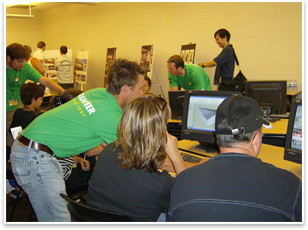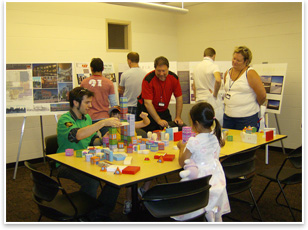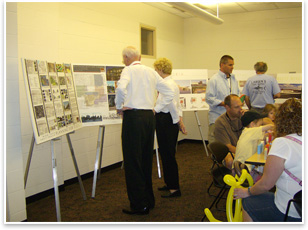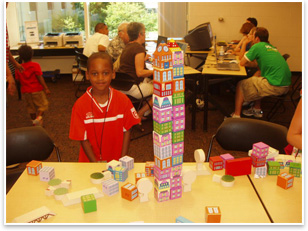 AIA Cleveland Exhibit Is Where Art and Architecture Meet AIA Cleveland Exhibit Is Where Art and Architecture Meet
Local component lets the public play architect
by Zach Mortice
Assistant Editor
Summary: AIA Cleveland’s ArchiTECHture exhibit gave visitors the tools to try their hand at building design and explore the role of the architect in society. Organized by the AIA Cleveland Government Affairs Committee, the exhibit was a chance to increase their public visibility in a setting that explored the link between art and technology.
Cleveland’s Ingenuity Fest was a multidisciplinary fair that explored the intersection of art and technology, where dancers’ movements created sound and image scapes and performance artists posed and reacted amid computer generated imagery. Perhaps more than other media, architecture already exists in this dynamic crossroads of utility and aesthetics, and that’s why Cleveland’s AIA component set up a booth at the festival that displayed the role of modern technology in architecture, or “ArchiTECHture,” as the exhibit was dubbed.
 A confluence of artists, musicians, technology experts, and speakers descended on downtown Cleveland’s Playhouse Square from July 19–22. This was the festival’s third year and the first time AIA Cleveland participated in it. The effort was sponsored by the component’s Government Affairs Committee as an AIA150 project and a way to boost their public visibility. “We used the vehicle of the Ingenuity Fest to bring architecture to the public,” says AIA Cleveland Executive Director Mary Helen Hammer. A confluence of artists, musicians, technology experts, and speakers descended on downtown Cleveland’s Playhouse Square from July 19–22. This was the festival’s third year and the first time AIA Cleveland participated in it. The effort was sponsored by the component’s Government Affairs Committee as an AIA150 project and a way to boost their public visibility. “We used the vehicle of the Ingenuity Fest to bring architecture to the public,” says AIA Cleveland Executive Director Mary Helen Hammer.
Wearing the architect’s hat
“It was sort of a leap of faith to put it together,” says Hammer, but she and her team cobbled together 40 volunteers to work at the exhibit and enlisted Avatech, a design software company, to provide computers. eBlueprint, a Web-based services company, provided printers.
 This group offered visitors a chance to “come play architect,” as organizer Christopher Tadych, AIA, says. SketchUp, Google’s free 3D design software, was installed on eight computers and local architects were on hand to advise novice designers on their work. This software exhibits Google’s penchant for intuitive yet powerful Web-based tools. It can be used to create models of massive skyscrapers or a single room, and all models are viewable internally and externally. The software’s designs can be placed on Google’s worldwide 3-D mapping program, Google Earth. In fact, amateur designers are filling in more 3D structures in their own neighborhoods with SketchUp every day. (Google also used SketchUp to design all of the AIA150 America’s Favorite Architecture models currently on Google Earth.) This group offered visitors a chance to “come play architect,” as organizer Christopher Tadych, AIA, says. SketchUp, Google’s free 3D design software, was installed on eight computers and local architects were on hand to advise novice designers on their work. This software exhibits Google’s penchant for intuitive yet powerful Web-based tools. It can be used to create models of massive skyscrapers or a single room, and all models are viewable internally and externally. The software’s designs can be placed on Google’s worldwide 3-D mapping program, Google Earth. In fact, amateur designers are filling in more 3D structures in their own neighborhoods with SketchUp every day. (Google also used SketchUp to design all of the AIA150 America’s Favorite Architecture models currently on Google Earth.)
“I think it was valuable for visitors to see something being designed in three dimensions,” says Tadych. “I think that’s a fact that most people don’t grasp.”
 Public, meet architect Public, meet architect
Recent AIA design award winners were invited to display their boards and prepare special materials with information on how technology enabled or affected their designs. One example of this, according to Angela Mazzi, AIA, chair of the Cleveland component’s Government Affairs Committee, was a public radio and TV broadcast facility that is also a live performance center for the arts. Younger, non-computer-savvy kids could also get their hands dirty with cityscape-styled building blocks.
Over the entire festival’s three days, 70,000 people visited, and ArchiTECHture received a great turnout too. Organizers said it was popular with families, kids, and young adults. Government Affairs Committee members are already starting to think about next year’s exhibit, which Mazzi says will perhaps feature non-traditional building materials. All these visitors, Hammer says, got a chance to learn about architect’s true role in the cities and towns in which they live.
 “I think people have a different and maybe easier perception of what the roles of other fields having to do with architecture, design, and engineering are, like construction,” she says. “People think architects are just somebody you might need to talk to if you’re going to build something. I don’t think that the average person understands how much school they have to go to and how much knowledge they have to acquire in order to perform their role and how critical they are to the design and building industry.” “I think people have a different and maybe easier perception of what the roles of other fields having to do with architecture, design, and engineering are, like construction,” she says. “People think architects are just somebody you might need to talk to if you’re going to build something. I don’t think that the average person understands how much school they have to go to and how much knowledge they have to acquire in order to perform their role and how critical they are to the design and building industry.”
The exhibit was also a conclusive answer for AIA members asking the question, “What is the AIA doing for me?” says Hammer. “People who are practitioners and members who had asked that question came in and said, ‘This is it! This is what the AIA should be doing.’”
|

 AIA Cleveland Exhibit Is Where Art and Architecture Meet
AIA Cleveland Exhibit Is Where Art and Architecture Meet
 A confluence of artists, musicians, technology experts, and speakers descended on downtown Cleveland’s Playhouse Square from July 19–22. This was the festival’s third year and the first time AIA Cleveland participated in it. The effort was sponsored by the component’s Government Affairs Committee as an AIA150 project and a way to boost their public visibility. “We used the vehicle of the Ingenuity Fest to bring architecture to the public,” says AIA Cleveland Executive Director Mary Helen Hammer.
A confluence of artists, musicians, technology experts, and speakers descended on downtown Cleveland’s Playhouse Square from July 19–22. This was the festival’s third year and the first time AIA Cleveland participated in it. The effort was sponsored by the component’s Government Affairs Committee as an AIA150 project and a way to boost their public visibility. “We used the vehicle of the Ingenuity Fest to bring architecture to the public,” says AIA Cleveland Executive Director Mary Helen Hammer.
 Public, meet architect
Public, meet architect “I think people have a different and maybe easier perception of what the roles of other fields having to do with architecture, design, and engineering are, like construction,” she says. “People think architects are just somebody you might need to talk to if you’re going to build something. I don’t think that the average person understands how much school they have to go to and how much knowledge they have to acquire in order to perform their role and how critical they are to the design and building industry.”
“I think people have a different and maybe easier perception of what the roles of other fields having to do with architecture, design, and engineering are, like construction,” she says. “People think architects are just somebody you might need to talk to if you’re going to build something. I don’t think that the average person understands how much school they have to go to and how much knowledge they have to acquire in order to perform their role and how critical they are to the design and building industry.”